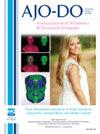Perception thresholds of dental and gingival asymmetries by orthodontists, dentists, and laypeople when observing close-up smile images using eye tracking technology
IF 2.7
2区 医学
Q1 DENTISTRY, ORAL SURGERY & MEDICINE
American Journal of Orthodontics and Dentofacial Orthopedics
Pub Date : 2025-02-01
DOI:10.1016/j.ajodo.2024.09.007
引用次数: 0
Abstract
Introduction
This study aimed to investigate the perception thresholds of dental and gingival asymmetries in close-up smile images for orthodontists, dentists, and laypeople.
Methods
Seven sets of close-up smile images were created, in which gingival and dental asymmetries were intentionally incorporated using a software-imaging program. The alterations included unilateral changes to the gingival border and incisal edge of the central and lateral incisors and crown width of the lateral incisor. Combination sets of both dental and gingival asymmetries together were also created. Eye-tracking technology was used to assess visual attention by measuring the fixation duration of the area of the alteration of each image by 195 participants in 3 groups: orthodontists, dentists, and laypeople. Statistical analysis was performed using analysis of variance with Bonferroni adjustment for multiple comparisons, to determine the perception thresholds for each group.
Results
Orthodontists and dentists perceived asymmetry of the gingival border of the central incisor at threshold levels of 1 mm, whereas laypeople perceived this asymmetry at 1.5 mm. Dentists and orthodontists were more sensitive to alterations in the gingival border of the lateral incisor, with a threshold of 1 mm, compared with laypeople, who had a threshold of 2 mm. Wear on the central incisor was perceptible at 1 mm for all groups, whereas wear on the lateral incisor was perceptible at 0.5 mm for orthodontists and dentists and 1 mm for laypeople. The perception threshold values for lateral width discrepancy were 2 mm for orthodontists, 3 mm for dentists, and 4 mm for laypeople.
Conclusions
On the basis of the perception thresholds found in this study, greater visual attention is drawn toward gingival asymmetries located closer to the midline and dental asymmetries that alter the smile arc.
使用眼动跟踪技术观察微笑特写图像时,正畸医生、牙科医生和普通人对牙齿和牙龈不对称的感知阈值。
简介本研究旨在调查正畸医生、牙科医生和普通人对特写微笑图像中牙齿和牙龈不对称的感知阈值:方法:研究人员制作了七组微笑特写图像,并使用软件成像程序有意识地在图像中加入牙龈和牙齿的不对称。这些改变包括单侧改变牙龈边缘、中切牙和侧切牙的切缘以及侧切牙的牙冠宽度。此外,还创建了牙齿和牙龈不对称的组合集。我们使用眼动跟踪技术来评估视觉注意力,方法是测量正畸医师、牙医和非专业人士三组 195 名参与者对每幅图像变化区域的固定持续时间。统计分析采用方差分析,并对多重比较进行了 Bonferroni 调整,以确定各组的感知阈值:结果:正畸医生和牙科医生认为中切牙牙龈边缘不对称的阈值为 1 毫米,而非专业人士认为这种不对称的阈值为 1.5 毫米。牙科医生和正畸医生对侧切牙牙龈边缘的变化更为敏感,阈值为 1 毫米,而普通人的阈值为 2 毫米。所有组别中,中切牙的磨损阈值均为 1 毫米,而正畸医师和牙医的侧切牙磨损阈值为 0.5 毫米,非专业人士的侧切牙磨损阈值为 1 毫米。正畸医生对侧宽差异的感知阈值为 2 毫米,牙科医生为 3 毫米,非专业人士为 4 毫米:根据本研究中发现的感知阈值,更接近中线的牙龈不对称和改变微笑弧度的牙齿不对称会引起更大的视觉注意。
本文章由计算机程序翻译,如有差异,请以英文原文为准。
求助全文
约1分钟内获得全文
求助全文
来源期刊
CiteScore
4.80
自引率
13.30%
发文量
432
审稿时长
66 days
期刊介绍:
Published for more than 100 years, the American Journal of Orthodontics and Dentofacial Orthopedics remains the leading orthodontic resource. It is the official publication of the American Association of Orthodontists, its constituent societies, the American Board of Orthodontics, and the College of Diplomates of the American Board of Orthodontics. Each month its readers have access to original peer-reviewed articles that examine all phases of orthodontic treatment. Illustrated throughout, the publication includes tables, color photographs, and statistical data. Coverage includes successful diagnostic procedures, imaging techniques, bracket and archwire materials, extraction and impaction concerns, orthognathic surgery, TMJ disorders, removable appliances, and adult therapy.

 求助内容:
求助内容: 应助结果提醒方式:
应助结果提醒方式:


